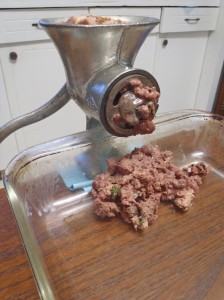This post was originally published on December 3, 2010. Re-posted today for Eat Alberta. I chose buffalo jerky for this year’s Eat Alberta tasting board because of the significant role that similar preparations played in the history of this province. Please read The Story of the Buffalo for more information.
 Jerky is my nominee for best representation of southern Alberta by a single food preparation. This is partly because of its historical connection to the buffalo hunt and ranching, but also because it takes advantage of the arid landscape. In dry regions jerky can safely be made on hot days, when the temperature is around 30°C, simply by leaving the sliced meat to hang outside.[1]
Jerky is my nominee for best representation of southern Alberta by a single food preparation. This is partly because of its historical connection to the buffalo hunt and ranching, but also because it takes advantage of the arid landscape. In dry regions jerky can safely be made on hot days, when the temperature is around 30°C, simply by leaving the sliced meat to hang outside.[1]
What Meat to Use.… Continue reading.
